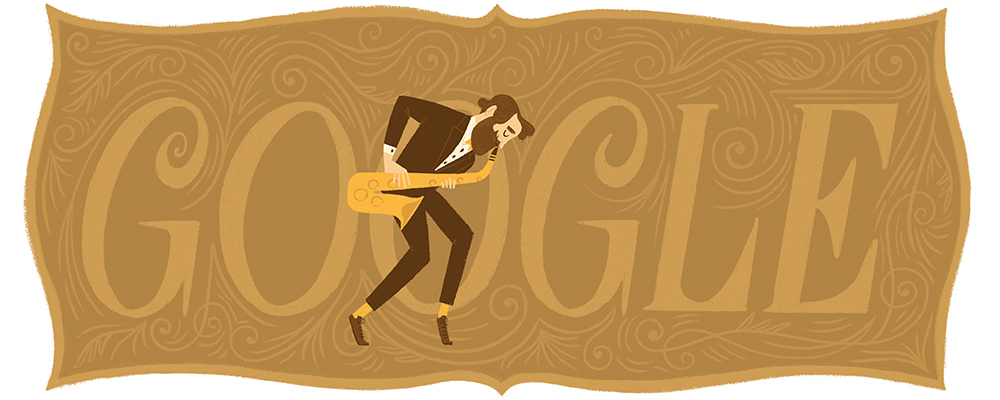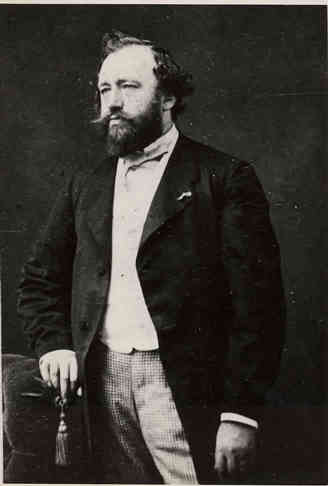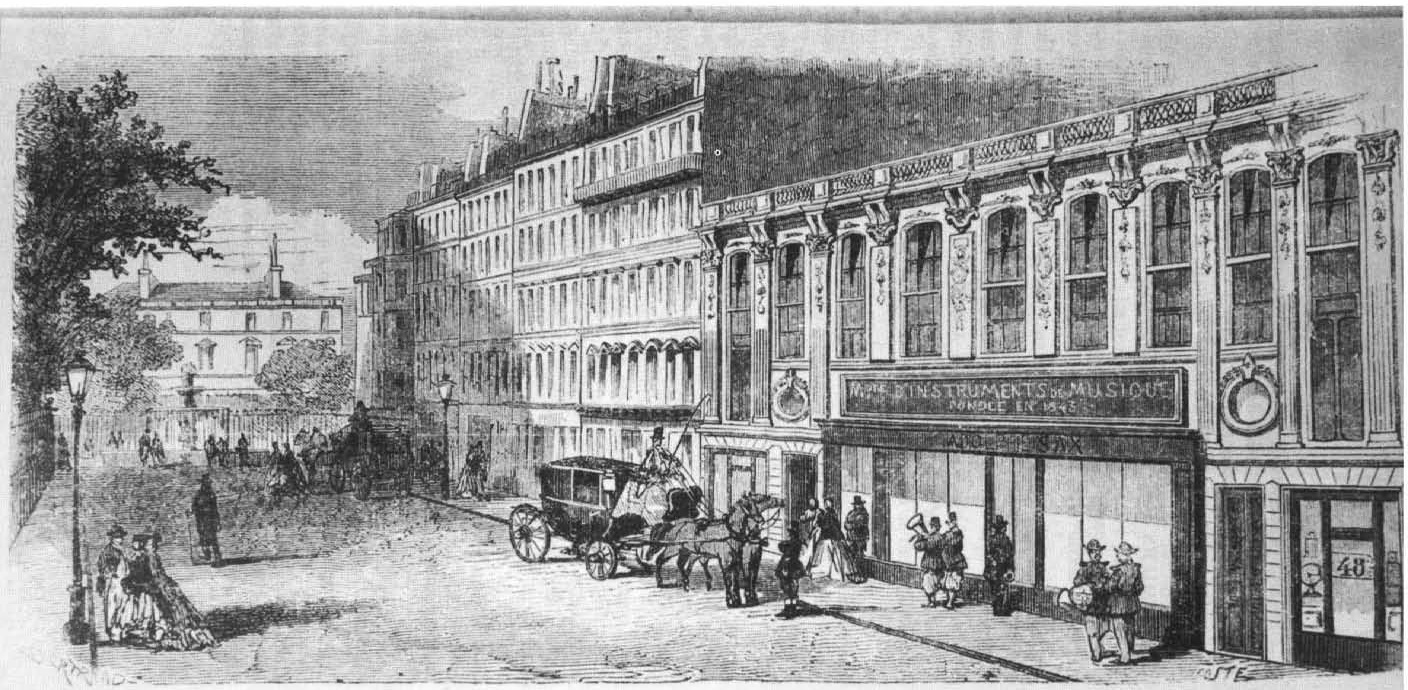
Adolphe Sax is being honored on his 201st birthday with a Google Doodle. (Google)
Adolphe Sax, a Belgian musician and instrument designer who invented the saxophone, is being celebrated on what would have been his 201st birthday with a Google Doodle.
Sax was born in Belgium, on November 6, 1814, and died on February 7, 1894, in Paris. He invented several several instruments during his lifetime, including an improvement of the bass clarinet and saxhorns. His saxophone design was patented in 1846.
“If you were alive in the mid-nineteenth century and had a particularly keen ear for music, you might have noticed a void somewhere between the brass and woodwind sections. Adolphe Sax certainly did, and being both a talented musician and the enterprising man that he was, he started tinkering and endeavored to fill it. The result was the iconic, honey-toned instrument still bearing his name: the saxophone,” Google says on its Doodle website. ”
Here’s what you need to know about Sax:
1. His Parents Were Also Instrument Designers & He Began Making Instruments at an Early Age

Adolphe Sax is best known for inventing the saxophone. (Wikipedia Commons)
Sax was born Antoine-Joseph Sax in Dinant, Belgium. He was called Adolf or Adolphe from a young age. According to PRI’s The World, Sax’s parents were instrument designers, and passed their craft down to their son, who was one of 11 children.
“The son of an instrument-maker, Sax was highly creative and had a deep understanding of brass and woodwinds. He started tinkering with instruments of his own, and upon bringing together the body of a brass and the mechanics of a woodwind created a hybrid that would revolutionize music. His eponymous saxophone had a sound all its own, a wonderfully smoky middle ground between the two,” Google says on its Doodle website.
“Little Adolphe had the opportunity to learn all about it in this workshop, and he was really great at it,” Jo Santy of the Museum of Musical Instruments in Brussels, told PRI. “He started out on his own instrument, the clarinet, more or less when he was 14 or 15 years old. He improved the instrument, changing the bore and exact locations of the holes, to make it sound better.”
Along with the saxophone, Sax invented several other instruments. You can learn more about the instruments he invented at the Google Cultural Institute.
The Bloomingdale School of Music says Sax was also a talented musician:
The son of Belgium’s appointed chief instrument maker, Adolphe would learn his father’s craft and quickly surpass him in both skill and vision. At age fifteen, he fabricated a clarinet and two flutes out of ivory, a feat previously deemed near impossible. By the age of twenty he had created a new fingering system for the clarinet and reinvented the bass clarinet, transforming it from an awkward derivative of the clarinet into the regal and elegant woodwind instrument it is today. He wasn’t limited to woodwinds, and is actually credited by many as the inventor of the modern trumpet, having been the first to successfully fuse piston valves into what we now call bugles. Adolphe wasn’t just an engineer; he was also a master instrumentalist. Trained at some of Europe’s finest conservatories, he could play, and play well, virtually every wind instrument of the time.
He moved to Paris in the 1840s, where the saxophone was born.
“His aim was nothing short of introducing a whole new range of instruments to the French Army, which was, of course, a huge market,” Santy said.
The saxophone, and other Sax inventions, were the result and he accomplished his goal.
“By definition, military bands are supposed to imbue a sense of power and confidence, but France’s military bands in the mid 1800s sounded so weak that they instead invoked laughter. Adolphe believed that his instruments, especially his saxophones, could turn the image of the French military bands completely around. Reluctant at first, the French adopted his instruments. The result was so effective that military bands from around the world were knocking on Adolphe’s door asking for his help, and his instruments,” according to the Bloomingdale School of Music’s history of the saxophone.
2. He Nearly Died Several Times as a Child

Sax was a musician who played the flute and clarinet. (Wikipedia Commons)
Sax almost did not make it through his childhood. According to a biography published on the city of Dinant’s website, Sax survived several near-death experiences.
“His childhood was tragic. Hardly able to stand, Antoine-Joseph fell from a height of three floors, seriously bumping his head against a stone: he was believed dead. At the age of three, he swallowed a bowl of vitriolized water, and then a pin. Later, he was seriously burned in a gunpowder explosion; he fell onto a cast iron frying pan and burned himself on one side. Three times he escaped poisoning and asphyxiation in his bedroom, where varnished items were lying about during the night. Another time, he was hit on the head by a cobblestone; he fell into a river and was saved by the skin of his teeth.”
“He’s a child condemned to misfortune; he won’t live,” his mother said, according to the biography. He was called “little Sax, the ghost,” in his neighborhood.
He was the eldest of 11 children, and only three others survived beyond their the age of 20.
3. He Went Bankrupt 3 Times While Fighting Lawsuits Brought by His Rivals
Sax drew the ire of his competitors in Paris after the invention of the saxophone. He went bankrupt three times while battling lawsuits from other designers, and when his 10-year patent ran out, his competition began designing their own versions, according to PRI’s The World.
“Again and again, Sax is the victim of persecutions worthy of the Middle Ages and that recall precisely the acts and deeds of Benveuto Cellini, the Florentine engraver. They took away his workmen, stole his plans, accused him of madness and took him to court. With a little more audacity, they would have murdered him. Such is the hatred that inventors always waken amongst those of their rivals that do not invent anything,” wrote Hector Berlioz, the classical composer who was one of Sax’s biggest champions.
According to a biography of Sax on his hometown’s website, the years after his invention of the saxophone were filled with difficulties:
The years that followed were to be awful for the inventor, who was to have to face up to the battle that his adversaries, his competitors and imitators waged against him and pushed to the extreme, who all organised themselves into a club to fight him. His staff were enticed away; musicians were prevented from using his instruments; disparaging articles were published, accompanied by hurtful caricatures. Saxophones were exported with the trade mark obliterated and then openly reintroduced to France after a few alterations and sealed with new seals. Sax was attacked before the courts to have his patents revoked.
It would take a book to relate all the court cases that were raised at all levels of jurisdiction. Sax won them all, not without claiming compensation, right until the final acknowledgement.
All these court cases ruined Sax, and he was declared bankrupt three times, in 1852, 1873 and 1877. And despite this, with approximately a hundred workers, some twenty thousand instruments left Sax’s workshops between 1843 and 1860!
4. He Survived Lip Cancer & Lived Until He Was 79

Adolphe Sax’s workshop. (Wikipedia Commons)
Sax continued to have brushes with death throughout his life. He suffered from lip cancer, typically a fatal diagnosis, from 1853 to 1858, but was able to make a rare full recovery. He was “successfully treated by an Afro-French herbalist,” according to Encyclopedia.com.
He was the father of five children with Spanish-born Louise-Adele Maor, according to The Saxophone by Stephen Cottrell, a book about his life. They were never married. Two of his children died during childhood.
While Sax had five children with Maor, he publicly distanced himself from her, possibly because of “concerns about social rank and perceptions of middle-class respectability,” Cottrell writes.
“It seems likely that Maor occupied a relatively humble position; she may have been one of Sax’s workers or even a domestic … which could explain how they met. In contrast, Sax generally moved in circles that would today be described as middle class, mixing with composers, writers and various dignitaries of the Parisian artistic scene.”
His youngest son, Adolphe-Edouard Sax, took over the family’s business after his father’s death in 1894.
5. The Saxophone Became Much More Popular After His Death

People walk past large saxophone art statues set up on the city’s main bridge as part of an exhibition “Art on Sax”, to mark the 200th birth anniversary of Adolphe Sax. (Getty)
Sax was a controversial figure among musicians and instrument designers during his lifetime, known for having a difficult personality.
“With Adolphe Sax, he was so controversial you were either for him or against him. This dangerous, dynamic, prolific Belgian who had arrived in Paris split up the musical world in France between pros and cons,” Jo Santy of the Museum of Musical Instruments in Brussels told PRI.
According to the Independent:
His success induced both panic and outrage amongst Parisian instrument makers, who united, virtually unanimously, against him under the umbrella of The Association of United Instrument Makers. Their tactics included lengthy legal proceedings to try to have the patents for the saxophone, saxhorn and saxotromba declared null and void, copying his instruments, trying to steal his workers away from him and, when all that failed, burning down his factory and trying to have him killed. Twice.
The saxophone was used in chamber music, orchestras and military bands during his lifetime. But it became much more popular after his death, when it reached the United States and became a staple for jazz musicians.
“It was love at first sight, really, between jazz musicians and the saxophone,” Santy told PRI. “They play like they would sing it, and the saxophone is a very good instrument to do that. You can cry and talk and weep and shout on the saxophone, like you do with your voice.”

